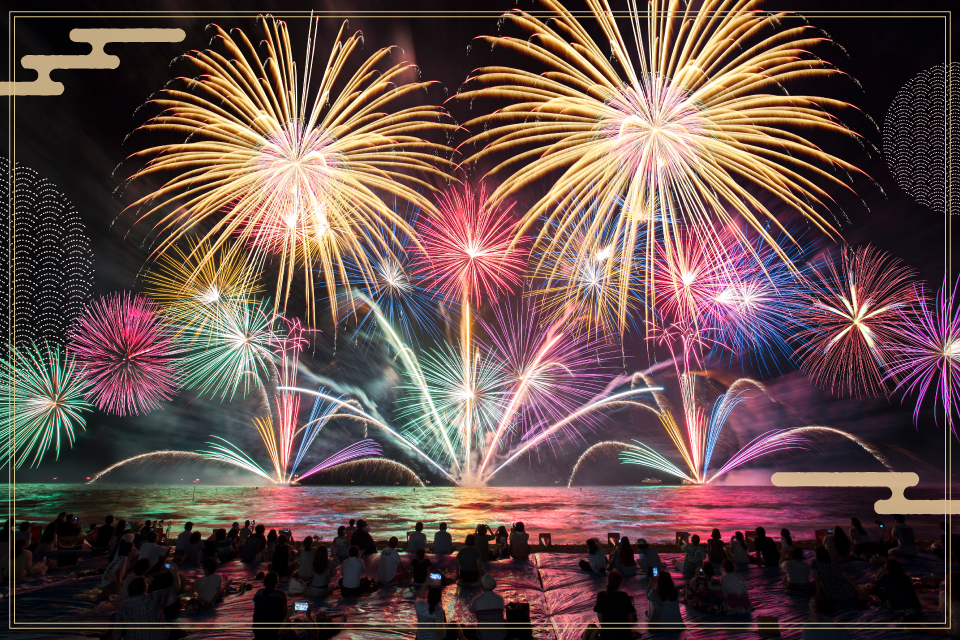

When a million people gather along Tokyo’s Sumida River, gazing at the sky in awe as 20,000 fireworks light up the night, it’s clear you’re witnessing something beyond entertainment — it’s the visible heartbeat of a Japanese summer. These festivals showcase Japan’s vibrant spirit and cultural richness, leaving unforgettable memories with their sheer scale and precision.
For travelers who’ve already explored temples and tasted sushi, fireworks festivals offer a deeper cultural experience. But to truly enjoy them, preparation is key — the intense heat, humidity, and long waits can be challenging without the right essentials.
Why Japan’s Fireworks Festivals Captivate the World
There’s something almost mystical about watching entire families emerge at dusk, dressed in vibrant yukata, streaming toward rivers and parks with quiet anticipation. They’re not merely attending a fireworks show; they’re participating in a ritual that connects them to centuries of tradition.
What sets Japanese fireworks festivals apart from their global counterparts is their treatment of pyrotechnics as high art. Master craftsmen called hanabi-shi dedicate decades to perfecting their craft, creating explosions that bloom like chrysanthemums or cascade like waterfalls. Each firework tells a story, synchronized with classical music to create emotional crescendos that leave even the most jaded observer breathless.
The scale amazes newcomers. A single festival can draw a million spectators, yet somehow maintains the organized tranquility Japan is famous for. Streets fill with the intoxicating aroma of yakitori and takoyaki while thousands spread blankets and wait with patient excitement for the magic to begin.
A History Written in Light
Japan’s fireworks culture began in 1733, born from grief and hope intertwined. The first display along Tokyo’s Sumida River wasn’t celebration—it was a memorial service for plague victims, using beauty to heal a community’s wounds. This tradition of finding hope through spectacular displays continues today, giving Japanese fireworks festivals their unique emotional resonance.
During the Edo period, two rival guilds—Tamaya and Kagiya—competed fiercely to create the most stunning displays. Their rivalry drove innovation and excellence, establishing techniques still used today. When crowds shout “Tamaya!” or “Kagiya!” during particularly impressive bursts, they’re continuing a tradition that spans three centuries.
The Meiji Restoration brought Western technology to Japanese craftsmanship, creating the perfect fusion of innovation and tradition. Modern festivals use computer-controlled timing and synchronized soundtracks, yet they maintain the artistic sensibility and community spirit that makes hanabi distinctly Japanese.
Japan’s Famous Fireworks Festivals: 4 Recommended Spots
Tokyo: Sumidagawa Fireworks Festival
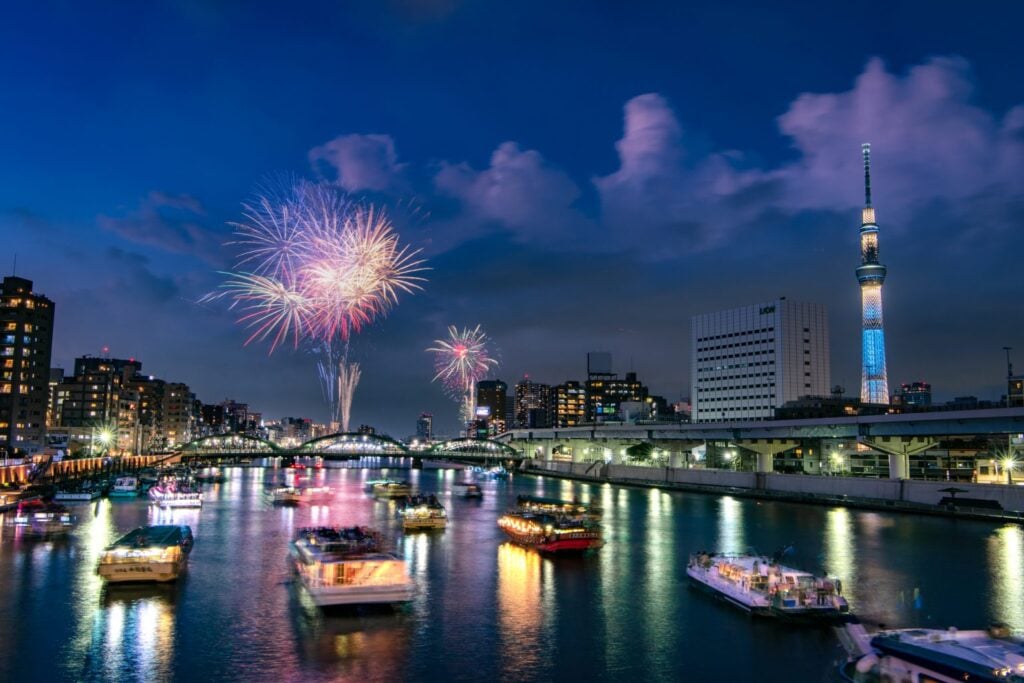
Tokyo’s crown jewel draws nearly a million spectators to the historic Sumida River each July. The urban setting creates stunning contrasts—traditional hanabi reflecting off modern skyscrapers while Tokyo Skytree provides a futuristic backdrop to centuries-old traditions. Twenty thousand fireworks launch from two riverside locations, ensuring excellent views from multiple vantage points.
This is the official website about Sumidagawa Fireworks Festival
Asakusa’s traditional districts, Ryogoku’s sumo stadium vicinity, and the modern Tokyo Skytree surroundings all offer unique perspectives. Getting there involves multiple train lines—Ginza Line or Tobu Skytree Line to Asakusa Station, JR Sobu Line to Ryogoku Station, or Tokyo Skytree Station. All connect to prime viewing areas within a 10-minute walk.
Critical timing matters: arrive before 3 PM as stations restrict entry once crowds peak, and free viewing areas fill by mid-afternoon. Paid seating (¥3,000+) guarantees spots but books quickly, making advance planning essential for optimal festival experiences.
Niigata :Nagaoka Matsuri Grand Fireworks Festival
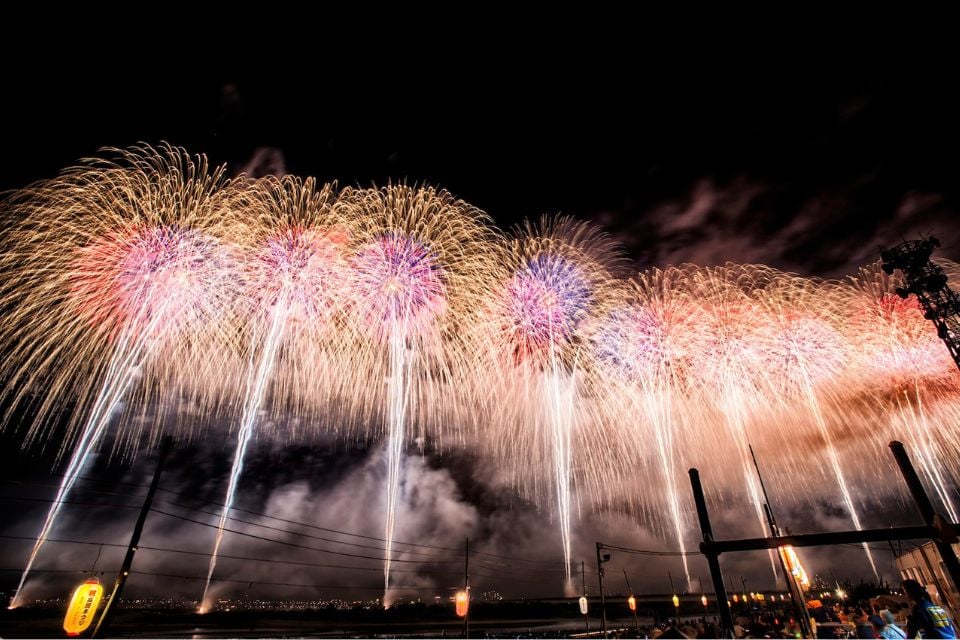
Prepare for profound emotional impact. This festival honors World War II victims while celebrating peace through breathtaking beauty. The legendary Sanshakudama—three-foot diameter shells—create chrysanthemum bursts spanning 650 meters across the sky. When these massive fireworks explode, you’ll feel sound waves in your chest.
The signature “Phoenix” sequence serves as the emotional centerpiece: five minutes of coordinated fireworks with classical music that moves audiences to tears. Over a million visitors attend this two-day August celebration, watching 20,000 fireworks paint the Niigata countryside.
Access: JR Joetsu Shinkansen from Tokyo to Nagaoka Station (100 minutes, ¥5,620). Festival shuttles run from the station, or walk 20 minutes to Shinano River viewing areas.
Booking Strategy: Reserve return tickets immediately after arrival—they sell out within hours of festival end.
This is the official website about Nagaoka Matsuri Grand Fireworks Festival
Akita :Omagari National Fireworks Competition
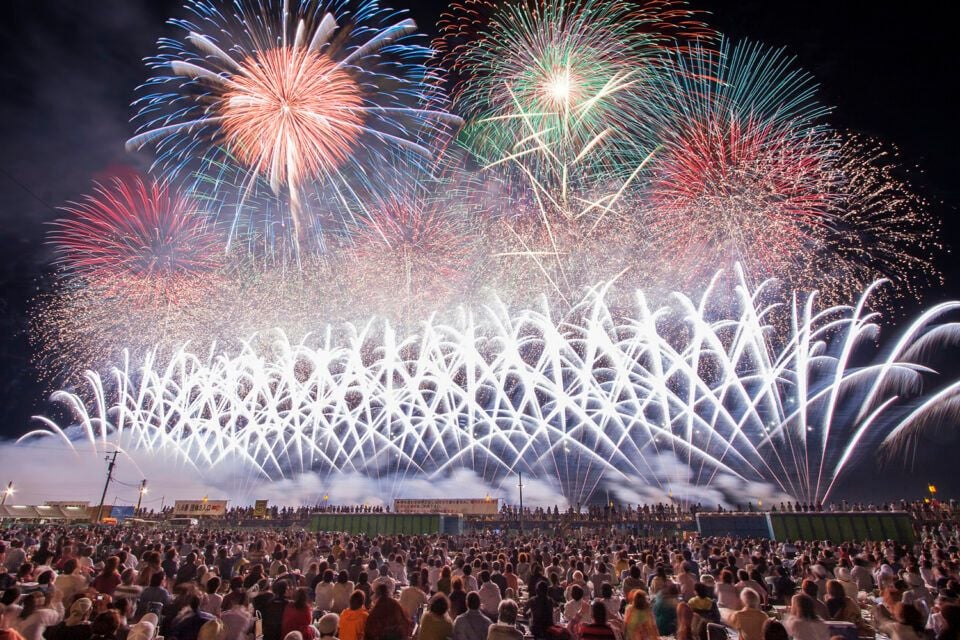
This isn’t entertainment—it’s art competition. Japan’s finest fireworks masters gather in rural Akita Prefecture each August, competing for national recognition. The competitive element drives innovation, with participants debuting techniques that influence festivals nationwide.
Eighteen thousand competition fireworks create a technical showcase along the Omono River. Minimal light pollution in this rural setting provides optimal viewing conditions for appreciating subtle artistry that urban festivals can’t match.
Journey: JR Akita Shinkansen from Tokyo to Akita Station (3 hours 40 minutes, ¥17,670), then JR Ou Main Line to Omagari Station (30 minutes, ¥500). Special festival trains operate on the event day.
Accommodation: Book months ahead or stay in Akita City for day trips—local lodging disappears quickly.
Shiga :Lake Biwa Fireworks Festival
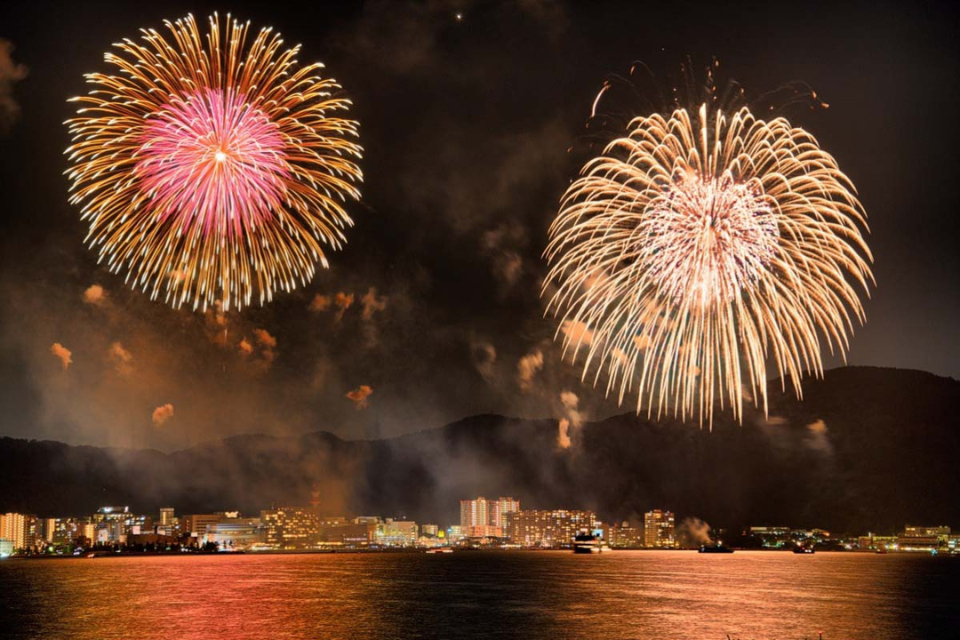
Japan’s largest lake creates a natural amphitheater for spectacular displays. Water surface reflections double the visual impact while the surrounding mountains amplify the sound for immersive experiences. This festival offers convenient access from Kyoto and Osaka, perfect for Kansai region exploration.
Ten thousand fireworks launch from lake barges, creating 360-degree viewing opportunities. The water setting provides unique photo opportunities unavailable at river or urban festivals.
Convenience Factor: From Kyoto Station, JR Tokaido Main Line to Otsu Station (10 minutes, ¥190). From Osaka, Keihan Main Line to Hamaotsu Station (40 minutes, ¥410).
Handy Goods to Enhance Your Japanese Fireworks Festival Experience
Japanese summers are beautiful but brutal. Temperatures soar above 30°C (86°F), humidity hovers near 80%, and you’ll spend hours in crowded outdoor spaces. Smart preparation transforms potential misery into magical experiences.
Traditional Uchiwa (Hand Fans)
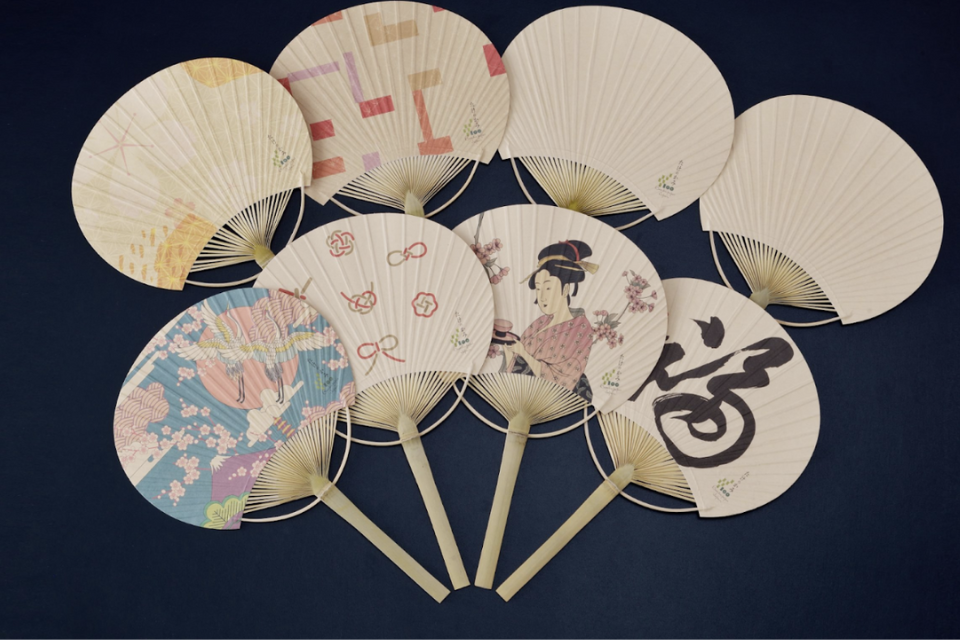
These aren’t just cooling devices—they’re cultural accessories that double as conversation starters. Beautifully designed and surprisingly effective, uchiwa cost between ¥100-¥300 at any convenience store.They require no batteries, make no noise, and provide that authentic festival feel that Instagram can’t capture.
Portable Electric Fans Modern handheld fans offer superior cooling power,
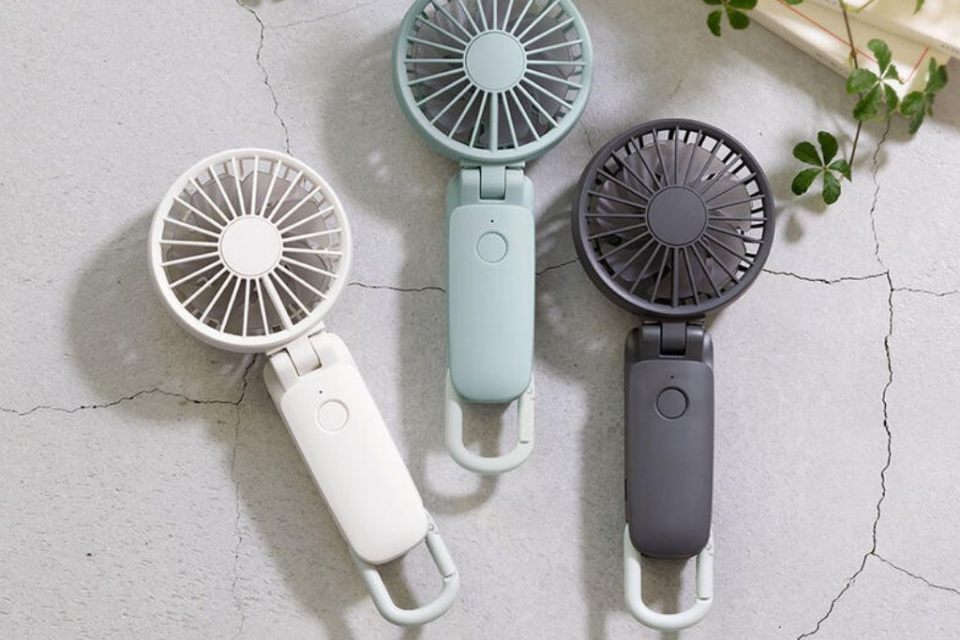
Though they drain batteries faster than you’d expect. Look for models with adjustable speeds and neck straps—your hands will thank you during those long waits. USB-rechargeable versions pair perfectly with power banks for extended use.
Cooling Towels
These technological marvels activate with water, providing instant relief when draped around your neck. Unlike regular wet towels, they stay cool for hours and can be reactivated multiple times. Essential for surviving those sweltering pre-festival hours.
Personal Misting Bottles A fine spray on your face and arms provides immediate relief from oppressive humidity. Choose bottles with adjustable nozzles—you want mist, not a water gun effect that soaks your neighbors.
Comfort Solutions for Long Waits
Folding Chairs
Back support becomes crucial during multi-hour waits, but check festival rules first—many restrict chair use in prime viewing areas. Lightweight models with carrying cases offer the best portability-comfort balance.
Portable Cushions
When chairs aren’t allowed, quality cushions save the day. Inflatable versions pack small and provide excellent comfort, while foam cushions offer more durability for frequent festival-goers.
Waterproof Ground Sheets
Evening dew and unexpected rain can ruin clothing and mood alike. Waterproof sheets protect against moisture while defining your personal space in crowded areas. Choose bright colors to help friends find you in massive crowds.
Essential Personal Care Items
Insect Repellent
Riverside festivals mean mosquitoes—lots of them. Japanese mosquitoes are persistent and numerous, making repellent non-negotiable rather than optional. Look for long-lasting formulations that won’t wash off with sweat.
Sunscreen
Even evening events require sun protection due to extended setup times and afternoon waits. Waterproof formulations resist sweat and humidity better than standard versions.
Portable Phone Chargers
Photography, navigation, and friend coordination drain batteries quickly. High-capacity power banks ensure you stay connected throughout long festival days. Look for models with multiple USB ports to help fellow festival-goers.
Compact Flashlights
Post-festival navigation becomes challenging in the dark. Small LED lights or phone flashlights help locate belongings and navigate crowded exit routes safely.
Where to Find Everything You Need
The good news? Japan makes festival preparation surprisingly easy, even for last-minute planners. From 24-hour convenience stores stocked with essentials to specialty shops offering premium comfort gear, the country’s retail infrastructure seems designed with festival-goers in mind. Here’s your insider guide to shopping smart and staying cool.
Convenience Stores: Your 24-Hour Lifeline
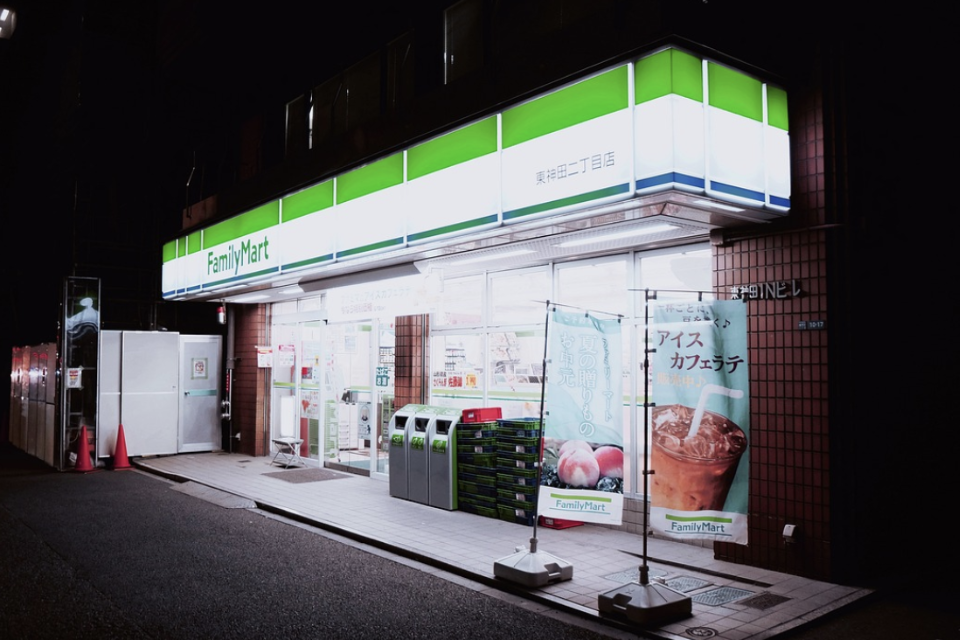
Seven-Eleven, FamilyMart, Lawson Japan’s convenience stores are miracle workers, stocking everything from basic uchiwa (¥100-¥300) to emergency phone chargers (¥1,000-¥3,000). Their greatest advantage? Availability. Festival morning panic-buying? No problem. Forgot insect repellent? They’ve got you covered.
Stock varies by location and season, but essentials like wet wipes, cooling towels, and portable fans are typically available. Prices run slightly higher than specialty stores, but convenience often trumps savings during festival season
100-Yen Shops: Budget-Conscious Solutions
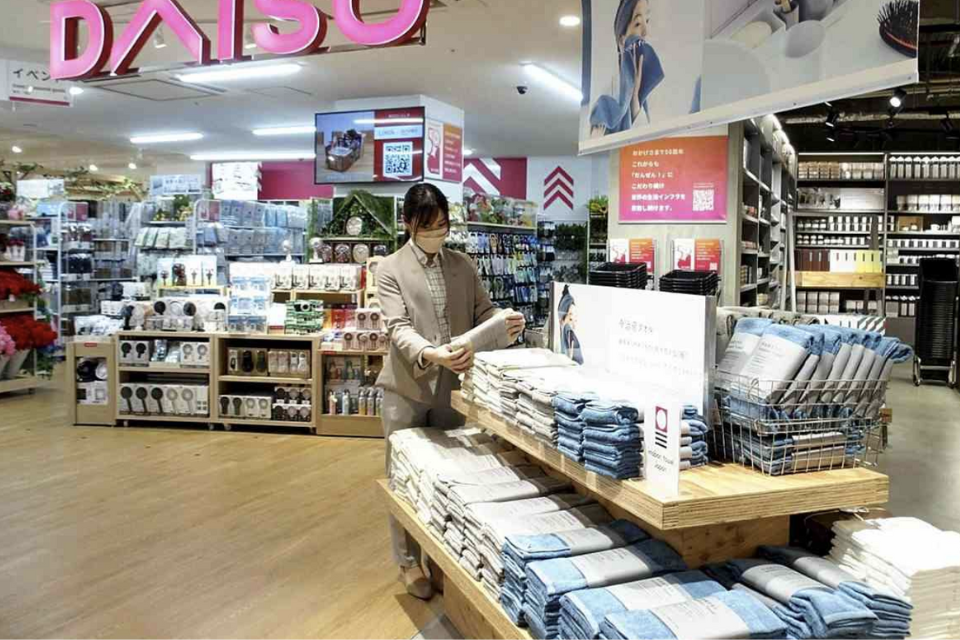
Daiso, Seria, Can Do These treasure troves offer remarkable value for festival preparation. Quality uchiwa, spray bottles, ground sheets, and portable cushions—all for ¥110 each. The selection impresses: decorative fans that work as well as expensive alternatives, cute spray bottles perfect for kids, and colorful ground sheets that actually repel water.
Don’t expect premium quality, but for single-use or occasional festival attendance, these stores can’t be beaten. Their compact uchiwa make excellent souvenirs too.
Electronics Retailers: Quality Cooling Solutions
When convenience store fans just won’t cut it, Japan’s electronics giants become your climate control headquarters. These tech wonderlands offer everything from whisper-quiet handheld fans to industrial-strength power banks that outlast the longest festival nights.
Yodobashi Camera, Bic Camera, Edion
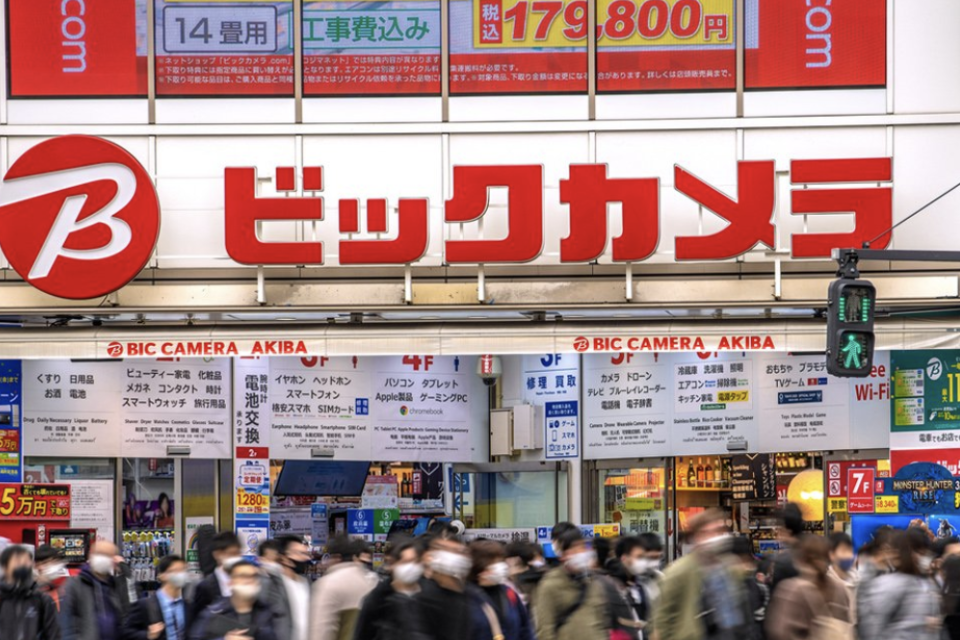
Yodobashi Camera, Bic Camera, Edion For serious cooling power, electronics stores deliver premium handheld fans (¥1,000-¥5,000), high-capacity power banks (¥2,000-¥8,000), and quality LED flashlights (¥500-¥2,000). Staff knowledge helps you choose between models, and return policies provide peace of mind for expensive purchases.
The ability to test products before buying proves invaluable—fan noise levels and battery life vary significantly between models.
Drugstores: Health and Comfort Specialists
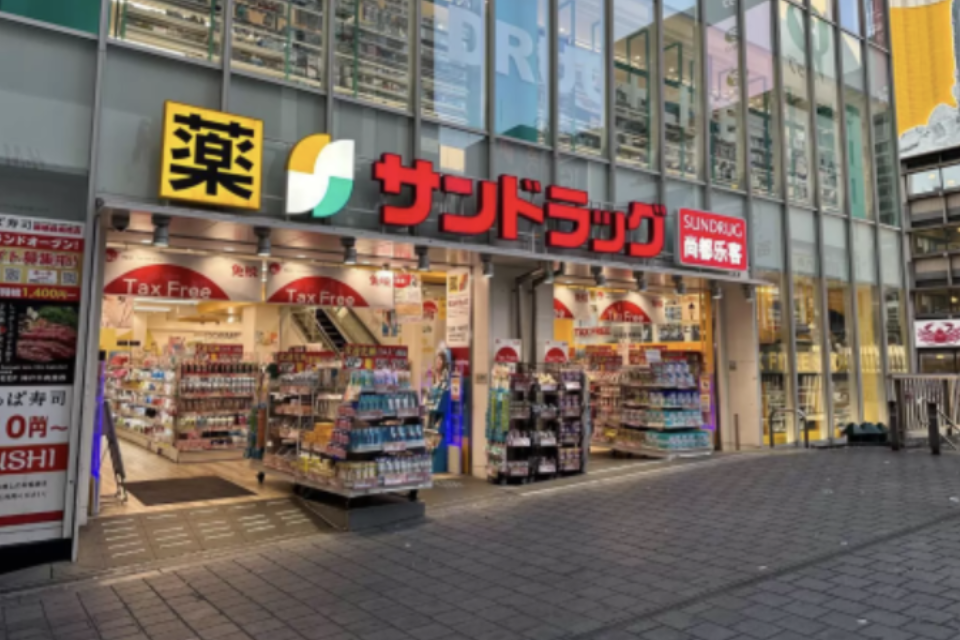
Matsumoto Kiyoshi, Welcia, Tsuruha These stores excel at personal care items: effective insect repellents (¥300-¥800), quality sunscreens (¥500-¥1,500), and specialized cooling towels (¥500-¥1,000). Pharmacist consultations help sensitive-skin customers choose appropriate products.
Their cooling towel selection often surpasses other retailers, with sports-specific options designed for extended outdoor use.
Home Centers: Serious Gear for Serious Festival-Goers
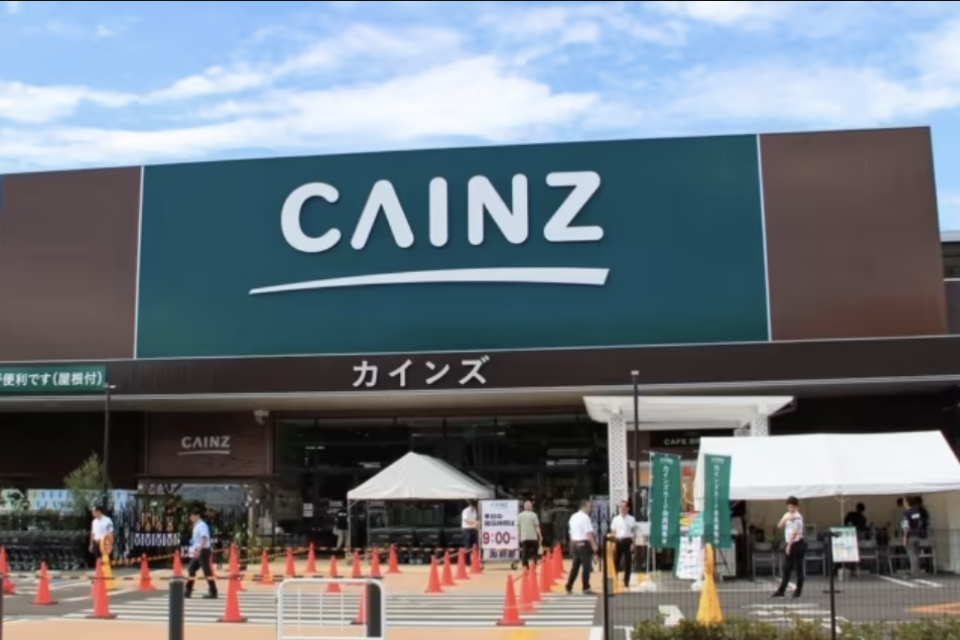
Cainz, Komeri, DCM Homac Outdoor gear specialists stock premium folding chairs (¥1,000-¥5,000), professional-grade ground sheets (¥500-¥3,000), and camping accessories that handle festival conditions with ease. Quality justifies higher prices, especially for frequent festival attendees.
Their outdoor sections feel like camping stores, complete with expert staff who understand extended outdoor comfort needs.
Creating Lasting Memories
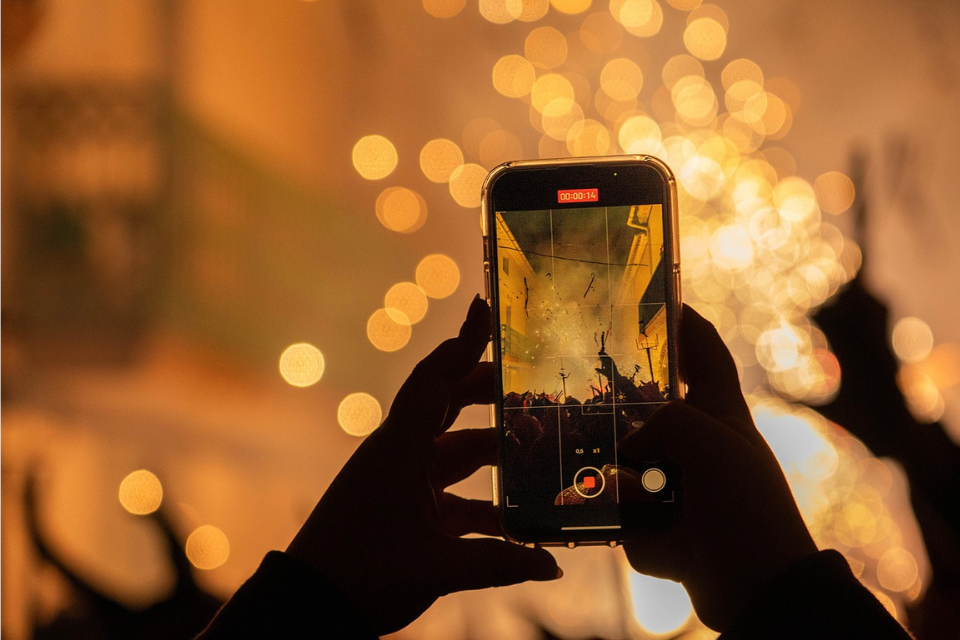
The real magic happens when you put down your phone and let yourself be fully present. While Instagram-worthy shots are tempting, the most profound festival experiences come from genuine moments of wonder—that collective gasp when a massive firework blooms overhead, or the quiet conversation with a Japanese family sharing their blanket space.
Photography Balance
Resist the urge to experience everything through a camera lens. Most impressive fireworks happen too quickly for preparation, so prioritize presence over perfect shots. Designate specific moments for photography while committing to experience climactic displays without technological mediation.
Cultural Connection
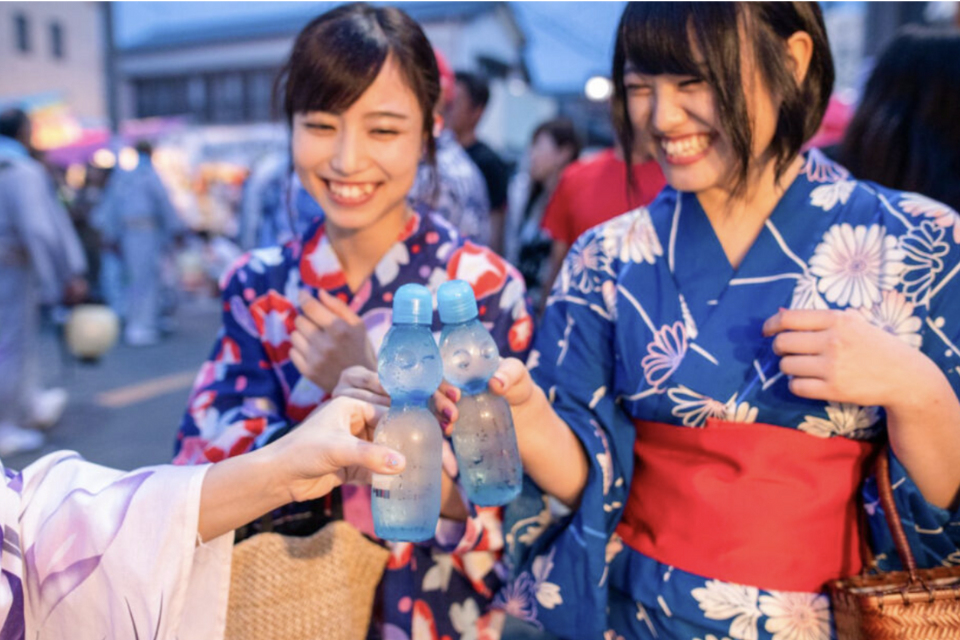
Shared wonder creates natural conversation opportunities with Japanese attendees. Learning basic phrases—”Sugoi!” (amazing!) and “Kirei!” (beautiful!)—enhances interactions while demonstrating cultural respect. Many Japanese festival-goers welcome chances to practice English with friendly international visitors.
Let’s check our interesting vlog too !
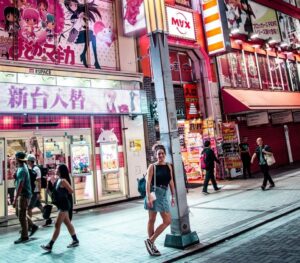
Weather Preparation
Summer weather changes rapidly, yet festivals proceed during light rain. Pack waterproof protection for electronics and documents, plus appropriate rain gear. Plan post-festival transportation carefully—millions of simultaneous departures create massive bottlenecks.
Consider walking to alternative stations or booking nearby accommodations rather than joining immediate exodus crowds. The extra planning prevents transportation stress from overshadowing magical experiences.
An Unforgettable Japanese Summer: Fireworks & Traditional Culture, Curated by MOTENAS JAPAN
Japan’s summer fireworks festivals are a breathtaking spectacle, captivating audiences worldwide with their magnificent beauty. The vibrant artistry painting the night sky is truly an awe-inspiring experience. But MOTENAS JAPAN offers more than just fireworks viewing; we provide a special evening infused with the true essence of Japanese “Omotenashi” (hospitality).
By blending traditional cultural experiences with fireworks viewing, we offer inbound travelers a unique and unparalleled journey. Imagine touching the heart of Japan through profound cultural immersion, followed by the dazzling brilliance of fireworks illuminating the night sky. With MOTENAS JAPAN’s specially curated plans, you can invite your clients to the ultimate Japanese experience.
Elegant “Evening of Wa” – The Serene Beauty of Tea Ceremony & Fireworks
Escape the crowds of the fireworks festival for a calming, authentic tea ceremony experience. Under the guidance of an expert instructor, guests will discover the spirit of Japanese “Wabi-Sabi” and enjoy a peaceful moment. Afterward, move to a private space to view the fireworks from an unobstructed, prime location. Savor the traditional beauty of Japan with all five senses, enhanced by the aroma of matcha, creating an unforgettable night.

Dynamic “Spirit of Iki” – Taiko Drumming & The Pulse of Fireworks
Experience the powerful resonance of Wadaiko (Japanese drums), often called the soul of Japan, through an interactive cultural activity. Under professional guidance, learn simple Taiko rhythms and discover their profound depth. After moving your body and feeling a sense of unity, we’ll guide you to a special viewing spot near the fireworks venue. With the lingering echoes of the Taiko, experience the booming sound and spectacular light of the fireworks up close, feeling the “Iki” (chic spirit) and passion of Japan.

Beyond the Spectacle
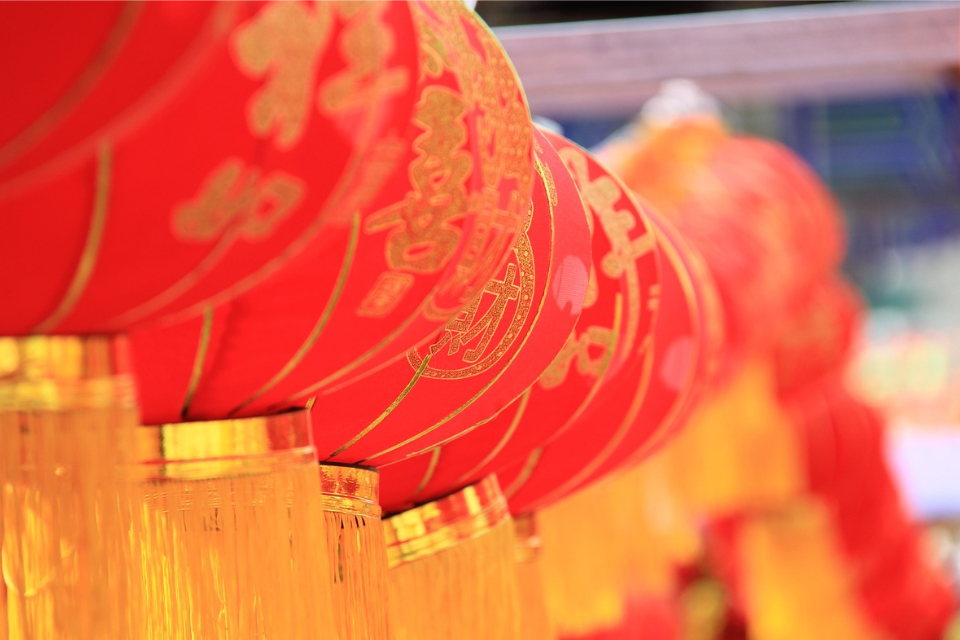
Japanese fireworks festivals offer windows into community life, artistic tradition, and cultural values that typical tourist attractions cannot provide. These events transform casual visitors into lifelong Japan enthusiasts, providing stories and insights that enrich understanding long after returning home.
The combination of spectacular artistry and cultural immersion creates experiences that satisfy both wonder and wanderlust. When properly prepared with the right gear from the right places, these festivals become the highlights of Japan journeys—moments when language barriers disappear and human connection transcends cultural differences.
Pack your cooling gear, charge your power banks, and prepare for memories that illuminate both night skies and the heart of Japanese community spirit. The magic awaits those ready to embrace it.
MOTENAS JAPAN can also create tailor-made plans to suit each client’s specific needs. Beyond these suggested itineraries, we can craft special experiences combining fireworks viewing with various traditional cultural activities like calligraphy, flower arrangement, or martial arts, all according to your requests.
This summer, to offer inbound tourists the finest Japanese experience, please don’t hesitate to consult with MOTENAS JAPAN. For detailed plans and pricing, feel free to contact us
Enjoy summer in Japn with great memories!





